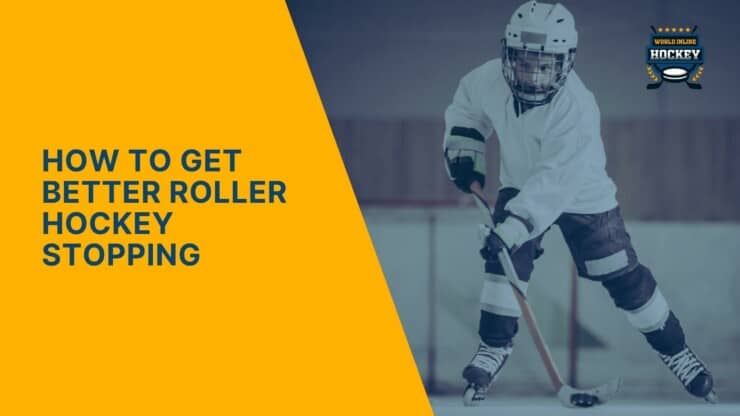Learning how to get better roller hockey stopping can be a challenging journey.
The reality is, when it comes to enhancing their game performance, many players’ primary struggle is…
Mastering how to get better roller hockey stopping,
This skill might seem elusive at first, but it’s what separates an average player from a great one.
If you don’t know how to execute precise and quick stops on your skates effectively, reaching that next level in your roller hockey career will remain just out of reach.
Achieving superior control over stopping isn’t easy folks.
To illustrate this point, consider the story of one aspiring player who told me about his countless falls and stumbles while trying to perfect his stop techniques.
Frustrated with numerous failed attempts he was ready to give up believing he would never master this critical aspect of the game.
Sounds familiar?
The Basics of Roller Hockey Stopping
Roller hockey, a thrilling sport that combines the speed and agility of ice hockey with the flexibility of roller skates, requires mastery over various stopping techniques.
A proper hockey stop is not merely about bringing your inline skates to a halt; it’s an art form in itself.
This skill can significantly enhance player performance on the rink while ensuring safety during high-speed games.
The Importance of Mastering Different Stops
In playing roller hockey, different situations call for different types of stops. The ability to execute these efficiently could mean outmaneuvering opponents or avoiding collisions at faster speeds.
Mastery over diverse stopping methods such as plow stop (V-stop), T-stop and even more advanced ones like spin-and-stop or Hockey Stop 2, adds versatility to one’s game-play style.
Beyond Simply Skating: Adding Style Points with Stopping Techniques
If you thought skating forward was all there is to roller sports – think again. From sliding sideways before coming into complete control over movements until achieving full stop – each technique has its unique charm and utility value.
Hence learning how back skate blade manipulation works might seem daunting initially but once mastered provides immense satisfaction apart from adding those extra style points.
To sum up mastering varied stopping techniques isn’t just about being good at braking when required but also enhancing overall maneuverability skills making you stand out among fellow players.
Naturally this takes us onto the next important aspect related closely towards our journey mastering perfect ‘stops’ – Safety Gear essentials.
Practice Makes Perfect – Improving Your Hockey Stops
Mastering the art of stopping in roller hockey, whether it’s a basic plow stop or an advanced hockey stop 2, requires consistent practice.
The Importance of Starting Slowly
In the initial stages, focus on simply skating forward at slow speeds. This allows you to understand how your inline skates respond and helps build confidence before attempting more complex moves.
As you gain proficiency with this simple task, try slowing down gradually by turning your skate blades slightly inward for a gentle stop. Remember that sudden stops can make you fall forward if not executed correctly.
Moving on Sliding Sideways
Beyond just moving straight ahead and coming to a complete stop, another skill worth mastering is sliding sideways. Similar to ice hockey players’ techniques but adapted for roller skates,
takes time and patience but pays off when trying faster speeds later on.
Faster Speeds & Advanced Moves
To take things up a notch once comfortable with these basics skills involves learning back skate blade manipulation; again start slowly then increase speed as control improves over time.
This fairly advanced tactic lets experienced players perform quick turns while maintaining balance even during high-speed games – something crucial in competitive playing scenarios like tournaments where every second counts.
FAQs in Relation to How to Get Better Roller Hockey Stopping
How can I improve my hockey stop?
To improve your hockey stop, practice regularly and start with basic techniques like the plow or V-stop and T-stop before moving on to more advanced methods.
How do you stop in roller hockey?
In roller hockey, stopping involves using techniques such as the plow or V-stop, T-stop, spin-and-stop, or a full-on hockey stop depending on your skill level.
How do I get better at roller hockey?
Becoming better at roller hockey requires consistent practice of skating skills including stopping techniques. Wearing proper gear also aids performance and safety.
How do you practice stopping in skates?
You can practice stopping in skates by starting slow with simple moves then gradually trying out complex ones once comfortable. Always remember to wear protective gear during sessions.
Conclusion
Mastering the art of roller hockey stopping is an exciting journey, not a destination.
You’ve learned how to get better roller hockey stopping, understanding the basics and gearing up right for safety.
The elbow pads are your friends in this adventure, providing protection as you practice those stops.
Then come the basic techniques like plow or V-stop and T-stop – they’re your stepping stones to becoming adept at controlling speed on skates.
Once you get comfortable, there’s no limit. You can explore advanced moves like spin-and-stop and even master the coveted hockey stop 2!
Falling safely? Yes, we covered that too because let’s face it; falls are part of learning any sport on wheels. But remember – awareness is key here!
Finally…
Remember one thing: Practice makes perfect! Start slow, be patient with yourself and gradually challenge yourself to try more complex maneuvers.
Ready to take your roller hockey skills to new heights?
At World Inline Hockey, we provide comprehensive guides tailored just for you – whether you are a beginner looking for basics or an experienced player aiming for mastery.
Dive into our resources today and see how much better your roller hockey stopping can become!

